Journal Papers

Polynomial Ridge Flowfield Estimation
A. Scillitoe, P. Seshadri, C. Y. Wong, A. B. Duncan
Physics of Fluids, 33(12), 127110 (2021)
PDF DOI ARXIV BIB
A. Scillitoe, P. Seshadri, C. Y. Wong, A. B. Duncan
Physics of Fluids, 33(12), 127110 (2021)
PDF DOI ARXIV BIB
Computational fluid dynamics plays a key role in the design process across many industries. Recently, there has been increasing interest in data-driven methods, in order to exploit the large volume of data generated by such computations. This paper introduces the idea of using spatially correlated polynomial ridge functions for rapid flowfield estimation. Dimension reducing ridge functions are obtained for numerous points within training flowfields. The functions can then be used to predict flow variables for new, previously unseen, flowfields. Their dimension reducing nature alleviates the problems associated with visualising high dimensional datasets, enabling improved understanding of design spaces and potentially providing valuable physical insights. The proposed framework is computationally efficient; consisting of either readily parallelisable tasks, or linear algebra operations. To further reduce the computational cost, ridge functions need only be computed at only a small number of subsampled locations. The flow physics encoded within covariance matrices obtained from the training flowfields can then be used to predict flow quantities, conditional upon those predicted by the ridge functions at the sampled points. To demonstrate the efficacy of the framework, the incompressible flow around an ensemble of aerofoils is used as a test case. On unseen aerofoils the ridge functions' predictive accuracy is found to be reasonably competitive with a state-of-the-art convolutional neural network (CNN). The local ridge functions can also be reused to obtain surrogate models for integral quantities such a loss coefficient, which is advantageous in situations where long-term storage of the CFD data is problematic. Finally, use of the ridge framework with varying boundary conditions is demonstrated on a three dimensional transonic wing flow.

Blade Envelopes Part II: Multiple Objectives and Inverse Design
C. Y. Wong, P. Seshadri, A. Scillitoe, B. N. Ubald, A. B. Duncan, G. Parks
Journal of Turbomachinery (2021)
PDF DOI ARXIV BIB
C. Y. Wong, P. Seshadri, A. Scillitoe, B. N. Ubald, A. B. Duncan, G. Parks
Journal of Turbomachinery (2021)
PDF DOI ARXIV BIB
Blade envelopes offer a set of data-driven tolerance guidelines for manufactured components based on aerodynamic analysis. In Part I of this two-part paper, a workflow for the formulation of blade envelopes is described and demonstrated. In Part II, this workflow is extended to accommodate multiple objectives. This allows engineers to prescribe manufacturing guidelines that take into account multiple performance criteria.
The quality of a manufactured blade can be correlated with features derived from the distribution of primal flow quantities over the surface. We show that these distributions can be accounted for in the blade envelope using vector-valued models derived from discrete surface flow measurements. Our methods result in a set of variables that allows flexible and independent control over multiple flow characteristics and performance metrics, similar in spirit to inverse design methods. The augmentations to the blade envelope workflow presented in this paper are demonstrated on the LS89 turbine blade, focusing on the control of loss, mass flow and the isentropic Mach number distribution. Finally, we demonstrate how blade envelopes can be used to visualize invariant designs by producing a 3D render of the envelope using 3D modelling software.

Blade Envelopes Part I: Concept and Methodology
C. Y. Wong, P. Seshadri, A. Scillitoe, A. B. Duncan, G. Parks
Journal of Turbomachinery (2021)
PDF DOI ARXIV BIB
C. Y. Wong, P. Seshadri, A. Scillitoe, A. B. Duncan, G. Parks
Journal of Turbomachinery (2021)
PDF DOI ARXIV BIB
Blades manufactured through flank and point milling will likely exhibit geometric variability. Gauging the aerodynamic repercussions of such variability, prior to manufacturing a component, is challenging enough, let alone trying to predict what the amplified impact of any in-service degradation will be. While rules of thumb that govern the tolerance band can be devised based on expected boundary layer characteristics at known regions and levels of degradation, it remains a challenge to translate these insights into quantitative bounds for manufacturing. In this work, we tackle this challenge by leveraging ideas from dimension reduction to construct low-dimensional representations of aerodynamic performance metrics. These low-dimensional models can identify a subspace which contains designs that are invariant in performance -- the inactive subspace. By sampling within this subspace, we design techniques for drafting manufacturing tolerances and for quantifying whether a scanned component should be used or scrapped. We introduce the blade envelope as a computational manufacturing guide for a blade. In this paper, the first of two parts, we discuss its underlying concept and detail its computational methodology, assuming one is interested only in the single objective of ensuring that the loss of all manufactured blades remains constant. To demonstrate the utility of our ideas we devise a series of computational experiments with the Von Karman Institute's LS89 turbine blade.

Uncertainty Quantification for Data-driven Turbulence Modelling with Mondrian Forests
A. Scillitoe, P. Seshadri, M. Girolami
Journal of Computational Physics, 430(1), 110116 (2021)
PDF DOI ARXIV BIB
A. Scillitoe, P. Seshadri, M. Girolami
Journal of Computational Physics, 430(1), 110116 (2021)
PDF DOI ARXIV BIB
Data-driven turbulence modelling approaches are gaining increasing interest from the CFD community. Such approaches generally aim to improve the modelled Reynolds stresses by leveraging data from high fidelity turbulence resolving simulations. However, the introduction of a machine learning (ML) model introduces a new source of uncertainty, the ML model itself. Quantification of this uncertainty is essential since the predictive capability of a data-driven model diminishes when predicting physics not seen during training. In this work, we explore the suitability of Mondrian forests (MF's) for data-driven turbulence modelling. MF's are claimed to possess many of the advantages of the commonly used random forest (RF) machine learning algorithm, whilst offering principled uncertainty estimates. An example test case is constructed, with a turbulence anisotropy constant derived from high fidelity turbulence resolving simulations. A number of flows at several Reynolds numbers are used for training and testing. MF predictions are found to be superior to those obtained from a linear and non-linear eddy viscosity model. Shapley values, borrowed from game theory, are used to interpret the MF predictions. Predictive uncertainty is found to be large in regions where the training data is not representative. Additionally, the MF predictive uncertainty is found to exhibit stronger correlation with predictive errors compared to an a priori statistical distance measure, which indicates it is a better measure of prediction confidence. The MF predictive uncertainty is also found to be better calibrated and less computationally costly than the uncertainty estimated from applying jackknifing to random forest predictions. Finally, Mondrian forests are used to predict the Reynolds discrepancies in a convergent-divergent channel, which are subsequently propagated through a modified CFD solver. The resulting flowfield predictions are in close agreement with the high fidelity data. A procedure for sampling the Mondrian forests' uncertainties is introduced. Propagating these samples enables quantification of the uncertainty in quantities of interest such as velocity or a drag coefficient, due to the uncertainty in the Mondrian forests' predictions. This work suggests that uncertainty quantification can be incorporated into existing data-driven turbulence modelling frameworks by replacing random forests with Mondrian forests. This would also open up the possibility of online learning, whereby new training data could be added without having to retrain the Mondrian forests.
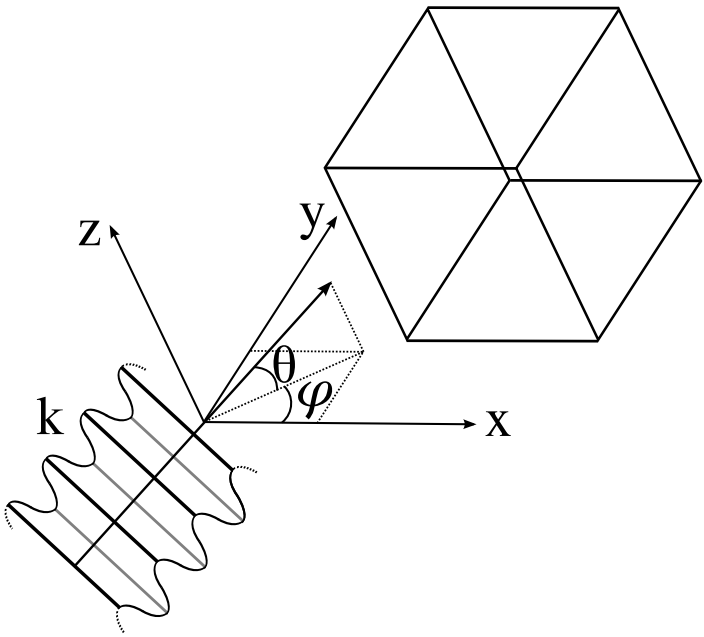
Effect of Mesh Quality on Flux Reconstruction in Multi-dimensions
W. Trojak, R. Watson, A. Scillitoe, P. G. Tucker
Journal of Scientific Computing, 82(3), 77, 1-36 (2020)
PDF DOI ARXIV BIB
W. Trojak, R. Watson, A. Scillitoe, P. G. Tucker
Journal of Scientific Computing, 82(3), 77, 1-36 (2020)
PDF DOI ARXIV BIB
Theoretical methods are developed to understand the effect of non-uniform grids on Flux Reconstruction (FR) in multi-dimensions. A better theoretical understanding of the effect of wave angle and grid deformation is established. FR is shown to have a smaller variation in properties than some finite difference counterparts. Subsequent numerical experiments on the Taylor–Green Vortex with jittered elements show the effect of localised regions of expansion and contraction. The effect this had on Nodal DG-like schemes was to increase the dissipation, whereas for more typical FR schemes the effect was to increase the dispersion. Some comparison is made between second-order FR and a second-order finite volume (FV) scheme. FR is found to be more resilient to mesh deformation, however, FV is found to be more resolved when operated at second order on the same mesh.

Modification of Shear Stress Transport Turbulence Model Using Helicity for Predicting Corner Separation Flow in a Linear Compressor Cascade
Y. Liu, Y. Tang, A. Scillitoe, P. G. Tucker
Journal of Turbomachinery, 142(2), 021004 (2020)
PDF DOI BIB
Y. Liu, Y. Tang, A. Scillitoe, P. G. Tucker
Journal of Turbomachinery, 142(2), 021004 (2020)
PDF DOI BIB
Three-dimensional corner separation significantly affects compressor performance, but turbulence models struggle to predict it accurately. This paper assesses the capability of the original shear stress transport (SST) turbulence model to predict the corner separation in a linear highly loaded prescribed velocity distribution (PVD) compressor cascade. Modifications for streamline curvature, Menter’s production limiter, and the Kato-Launder production term are examined. Comparisons with experimental data show that the original SST model and the SST model with different modifications can predict the corner flow well at an incidence angle of −7 deg, where the corner separation is small. However, all the models overpredict the extent of the flow separation when the corner separation is larger, at an incidence angle of 0 deg. The SST model is then modified using the helicity to take account of the energy backscatter, which previous studies have shown to be important in the corner separation regions of compressors. A Reynolds stress model (RSM) is also used for comparison. By comparing the numerical results with experiments and RSM results, it can be concluded that sensitizing the SST model to helicity can greatly improve the predictive accuracy for simulating the corner separation flow. The accuracy is quite competitive with the RSM, whereas in terms of computational cost and robustness it is superior to the RSM.
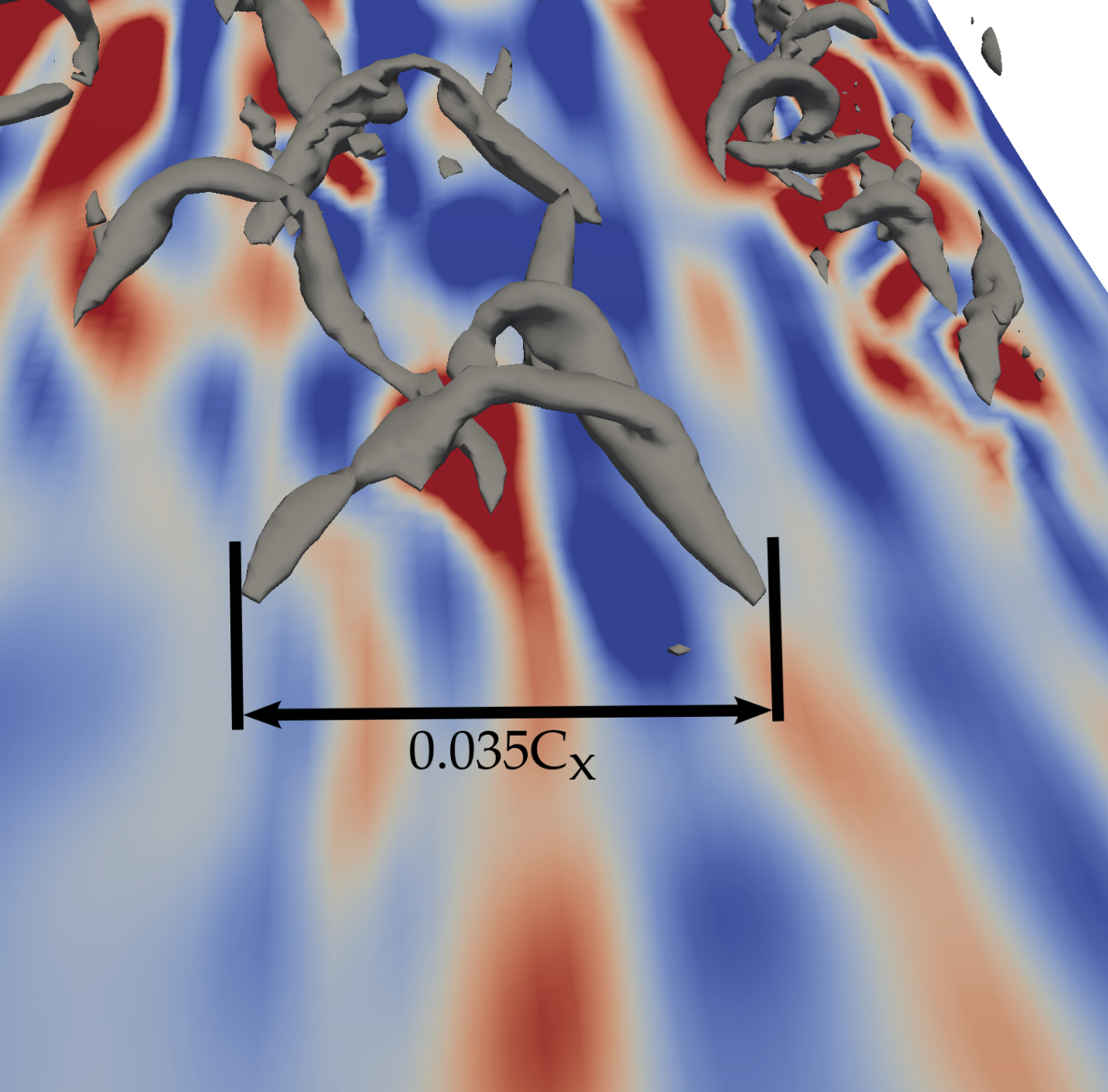
Large eddy simulation of boundary layer transition mechanisms in a gas-turbine compressor cascade
A. Scillitoe, P. G. Tucker, P. Adami
Journal of Turbomachinery, 141(6), 061008 (2019)
PDF DOI BIB
A. Scillitoe, P. G. Tucker, P. Adami
Journal of Turbomachinery, 141(6), 061008 (2019)
PDF DOI BIB
Large eddy simulation (LES) is used to explore the boundary layer transition mechanisms in two rectilinear compressor cascades. To reduce numerical dissipation, a novel locally adaptive smoothing (LAS) scheme is added to an unstructured finite volume solver. The performance of a number of subgrid scale (SGS) models is explored. With the first cascade, numerical results at two different freestream turbulence intensities (Ti's), 3.25% and 10%, are compared. At both Ti's, time-averaged skin-friction and pressure coefficient distributions agree well with previous direct numerical simulations (DNS). At Ti = 3.25%, separation-induced transition occurs on the suction surface, while it is bypassed on the pressure surface. The pressure surface transition is dominated by modes originating from the convection of Tollmien–Schlichting waves by Klebanoff streaks. However, they do not resemble a classical bypass transition. Instead, they display characteristics of the “overlap” and “inner” transition modes observed in the previous DNS. At Ti = 10%, classical bypass transition occurs, with Klebanoff streaks incepting turbulent spots. With the second cascade, the influence of unsteady wakes on transition is examined. Wake-amplified Klebanoff streaks were found to instigate turbulent spots, which periodically shorten the suction surface separation bubble. The celerity line corresponding to 70% of the free-stream velocity, which is associated with the convection speed of the amplified Klebanoff streaks, was found to be important.

Numerical investigation of three-dimensional separation in an axial flow compressor: the influence of freestream turbulence intensity and endwall boundary layer state
A. Scillitoe, P. G. Tucker, P. Adami
Journal of Turbomachinery, 139(2), 021011 (2017)
PDF DOI BIB
A. Scillitoe, P. G. Tucker, P. Adami
Journal of Turbomachinery, 139(2), 021011 (2017)
PDF DOI BIB
Regions of three-dimensional separations are an inherent flow feature of the suction surface-endwall corner in axial compressors. These corner separations can cause a significant total pressure loss and reduce the compressor's efficiency. This paper uses wall-resolved LES to investigate the loss sources in a corner separation, and examines the influence of the inflow turbulence on these sources. Different subgrid scale (SGS) models are tested and the choice of model is found to be important. The σ SGS model, which performed well, is then used to perform LES of a compressor endwall flow. The time-averaged data are in good agreement with measurements. The viscous and turbulent dissipation are used to highlight the sources of loss, with the latter being dominant. The key loss sources are seen to be the 2D laminar separation bubble and trailing edge wake, and the 3D flow region near the endwall. Increasing the freestream turbulence (FST) intensity changes the suction surface boundary layer transition mode from separation induced to bypass. However, it does not significantly alter the transition location and therefore the corner separation size. Additionally, the FST does not noticeably interact with the corner separation itself, meaning that in this case the corner separation is relatively insensitive to the FST. The endwall boundary layer state is found to be significant. A laminar endwall boundary layer separates much earlier leading to a larger passage vortex. This significantly alters the endwall flow and loss. Hence, the need for accurate boundary measurements is clear.
Conference Proceedings

Programming with equadratures: an open-source package for uncertainty quantification, dimension reduction, and much more
P. Seshadri, C. Y. Wong, A. Scillitoe, B. N. Ubald, B. Hill, I. Virdis, T. Ghisu, A. B. Duncan
Proceedings of AIAA SciTech Forum, San Diego, USA (2022)
PDF DOI BIB
P. Seshadri, C. Y. Wong, A. Scillitoe, B. N. Ubald, B. Hill, I. Virdis, T. Ghisu, A. B. Duncan
Proceedings of AIAA SciTech Forum, San Diego, USA (2022)
PDF DOI BIB
This paper presents an overview of the open-source code equadratures. While originally developed to replicate polynomial chaos results seen in literature, it has since evolved to touch upon multiple aspects of computational engineering and machine learning. Today, the code uses orthogonal polynomial approximations to facilitate various parameter-based studies including uncertainty quantification, sensitivity analysis, dimension reduction, and classification. Additionally, it can address well-known limitations of polynomial approximations. These include the ability to fit to high-dimensional problems without requiring large input-output data pairs, and the ability to negotiate discontinues in any provided data. For the former, subspace-based polynomial approximations are employed, while for the latter, a tree-based piecewise polynomial hierarchy is adopted. Beyond this, ancillary topics such as coefficient computation, dealing with correlated inputs, moment computation, and gradient enhancement are also discussed. Following a deep-dive of the underpinning methods in the code, this paper details numerous case studies—with a slant towards computational aerodynamic problems.
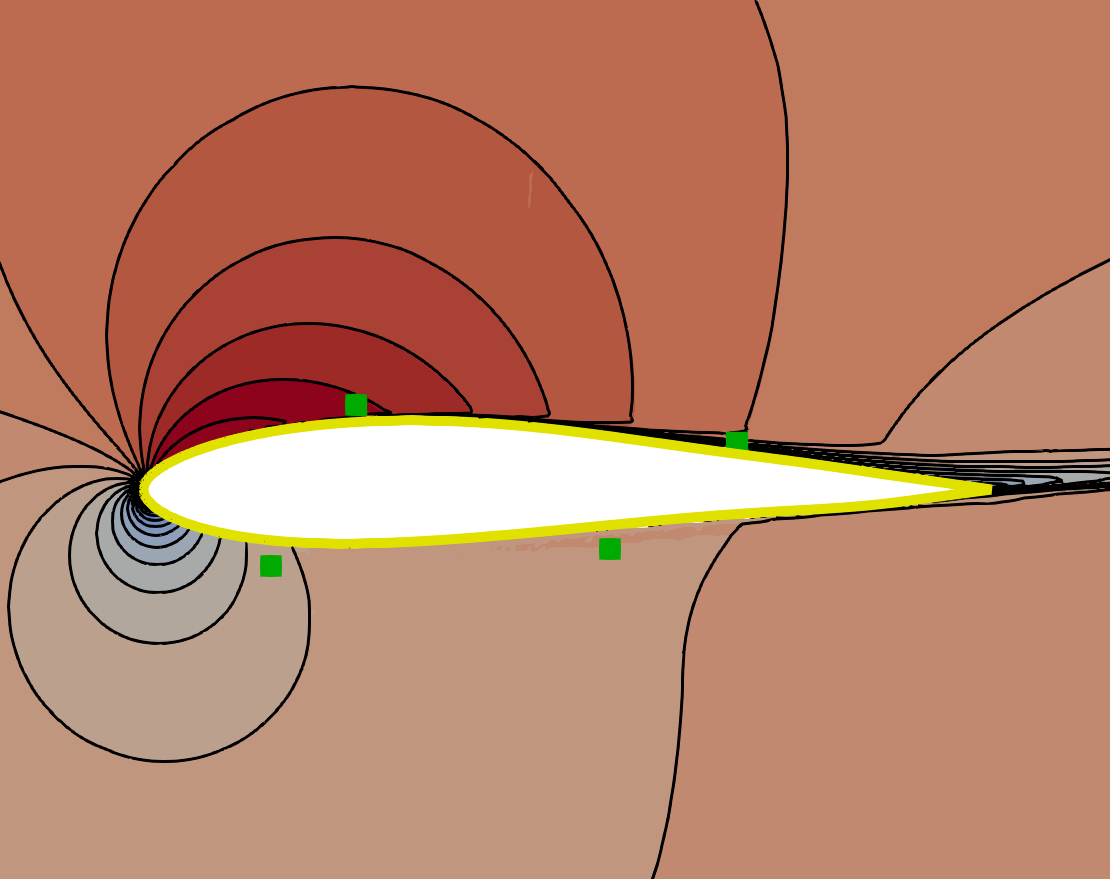
Instantaneous Flowfield Estimation with Gaussian Ridges
A. Scillitoe, P. Seshadri and C. Y. Wong
Proceedings of AIAA SciTech Forum, virtual event (2021)
PDF DOI BIB
A. Scillitoe, P. Seshadri and C. Y. Wong
Proceedings of AIAA SciTech Forum, virtual event (2021)
PDF DOI BIB
Computational fluid dynamics plays a key role in the design process across many industries. Recently, there has been increasing interest in data-driven methods, in order to exploit the large volume of data generated by such computations. This paper introduces embedded Gaussian ridge functions, for rapid flowfield predictions. Gaussian ridge functions, which involve fitting a Gaussian process over a dimension reducing subspace, are obtained for numerous points within training flowfields. The functions can then be used to predict flow variables for new, previously unseen, flowfields. Their dimension reducing nature alleviates the problems associated with visualising high dimensional datasets, enabling improved understanding of design spaces and potentially providing valuable physical insights. A training and prediction framework is proposed, and demonstrated on the incompressible flow around a set of aerofoils. The framework is computationally efficient; consisting of either heavily parallelizable tasks, or linear algebra operations. To further reduce the computational cost, the computational grid is randomly subsampled, and ridge functions are obtained only at the sampled points. The flow physics encoded within covariance matrices obtained from the training flowfields is explored, and it is found that only a number of the leading modes are required to capture most of the relevant physics. This physics can be used to predict flow quantities, conditional upon those predicted by the ridge functions at the sampled points. This enables full flowfield predictions to be obtained, despite only having ridge functions at a small number of sample points. The resulting flowfield predictions are found to be competitive with those given by a state-of-the-art convolutional neural network trained on the same data. The underlying Gaussian processes allow for principled uncertainty quantification. Their posterior variance is incorporated into the covariance matrices, resulting in the upsampled flowfield predictions falling back on prior knowledge when predictive uncertainty is high. The end user can also view this uncertainty, giving them increased confidence in predictions. Additionally, this the possibility of including the CFD uncertainties within the framework exists, allowing for uncertainties in the CFD training data to be accounted for in the frameworks final predictions.
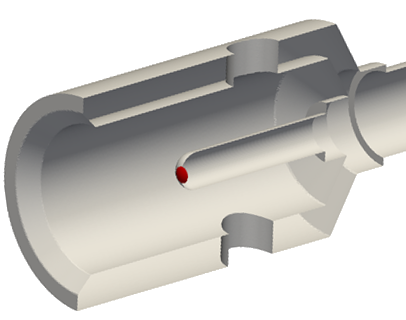
Design Space Exploration of Stagnation Temperature Probes via Dimension Reduction
A. Scillitoe, B. N. Ubald, P. Seshadri, S. Shahpar
Proceedings of ASME Turbo Expo, virtual event (2020)
PDF DOI BIB
A. Scillitoe, B. N. Ubald, P. Seshadri, S. Shahpar
Proceedings of ASME Turbo Expo, virtual event (2020)
PDF DOI BIB
The measurement of stagnation temperature is important for turbomachinery applications as it is used in the calculation of component efficiency and engine specific fuel consumption. This paper examines the use of polynomial variable projection to identify dimension reducing subspaces for stagnation temperature probes. As an example application we focus on a simplified Kiel probe geometry, but the proposed data-centric approach could be readily applied to new datasets with different geometries, boundary conditions and design objectives. The design of Kiel probes is non-trivial, with a large design space, complex flow physics, and competing design objectives. Two design objectives are considered: (1) the stagnation pressure loss, to reduce instrumentation losses; (2) the change in recovery ratio with respect to Mach number, to reduce temperature measurement uncertainty. Subspaces are obtained for the two design objectives, allowing the influence of seven design parameters to be understood. The entropy generation rate is used to provide physical insights into loss mechanisms. The recovery ratio subspace indicates that for the present probe there is an optimum vent-to-inlet area which minimises the change in recovery ratio with respect to Mach number, and design modifications that yield further small improvements are explored. Finally, the uncertainty in recovery ratio due to manufacturing variability is shown to be important. In comparison to global sensitivity measures, the use of an active subspace is shown to provide important information on what manufacturing tolerances are important for specific designs. New designs can also be selected that are insensitive to given manufacturing tolerances.

Effect of Flux Function Order and Working Precision in Spectral Element Methods
W. Trojak, A. Scillitoe, R. Watson
Proceedings of AIAA SciTech Forum, Orlando, Florida (2020)
PDF DOI BIB
W. Trojak, A. Scillitoe, R. Watson
Proceedings of AIAA SciTech Forum, Orlando, Florida (2020)
PDF DOI BIB
Through this work, we have sought to challenge two received wisdoms in CFD. The first of these was the use of primitive variables to construct flux functions. We compared the use of primitives with conserved variables and showed numerically that a noticeable difference can be seen in methods that use reconstruction. Analysis using Taylor's theorem showed that this is primarily due to the flux function order --- and as order increases, the difference found will become increasingly important. An investigation into the effects of these choices on the method for constructing the viscous flux was also performed. When reconstructing from the conserved variables there are two potential methods, where either primitives are used as an intermediary or the product rule is used. Analysis showed a clear difference between the approaches, however in numerical investigations, these differences were limited due to the typically small magnitude of the viscous terms. A final investigation was performed that aimed to challenge the dogma that double precision is important in CFD calculations. Numerical investigations on transitional flows showed that differences between single and double precision were negligible. However, differences become more noticeable over long-time integration, which can be attributed to two things. Firstly, that in single-precision error accumulation will become apparent more quickly under explicit temporal integration due to the larger relative error. Secondly, in this case, the range of the variable fields reduces with time due to dissipation, and so as time proceeds the absolute error from early on will get relatively larger. These points also highlight some key considerations when reducing the precision, due to the increased relative error of lower precision care has to be taken in accumulation. For example, when calculating globally averaged statistics or in statistics calculated through many operations.
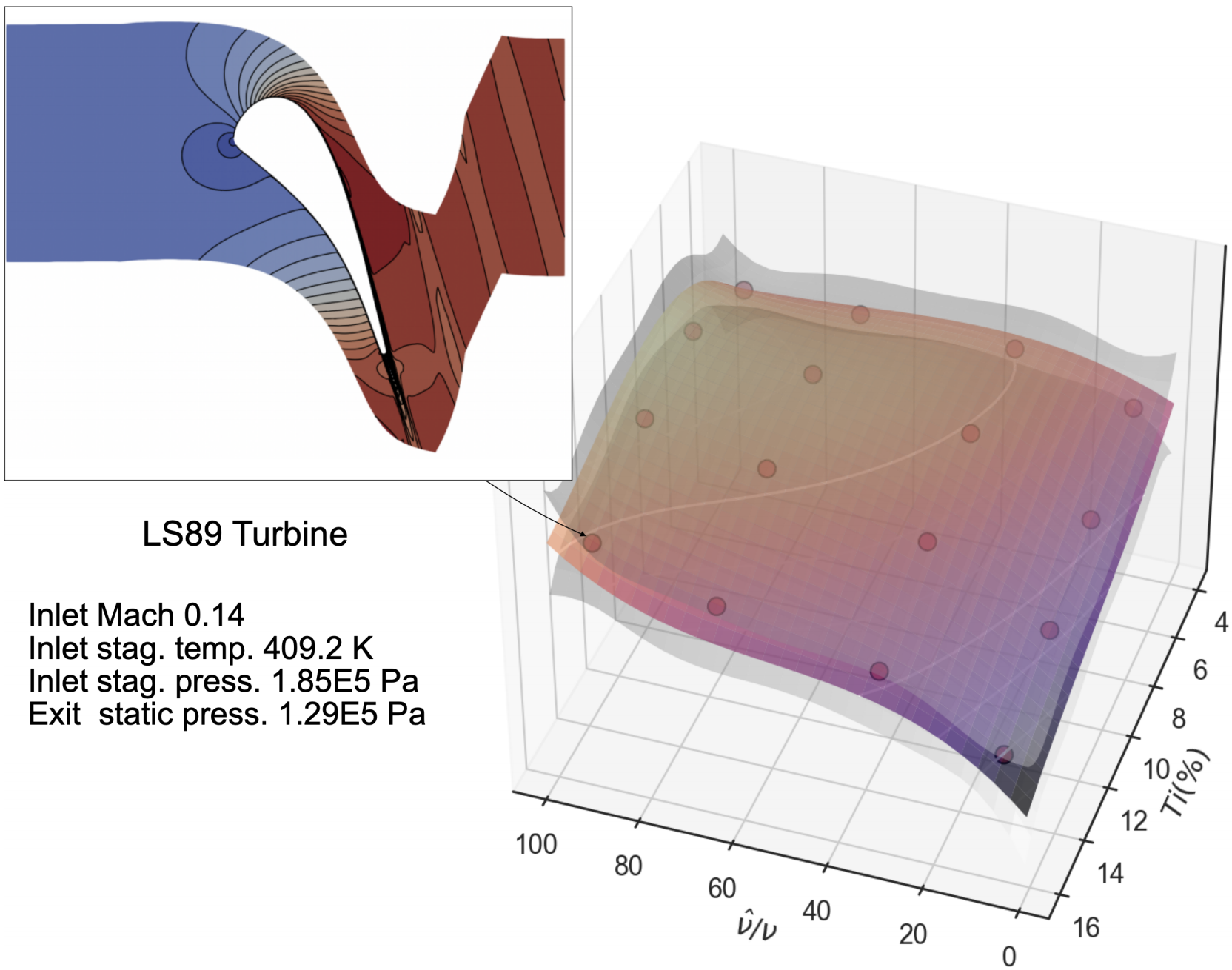
Bayesian Polynomial Chaos
P. Seshadri, A. B. Duncan, A. Scillitoe
Proceedings of Machine Learning for Engineering Modeling, Simulation, and Design Workshop at NeurIPS (2020)
PDF
P. Seshadri, A. B. Duncan, A. Scillitoe
Proceedings of Machine Learning for Engineering Modeling, Simulation, and Design Workshop at NeurIPS (2020)
In this brief paper we introduce Bayesian polynomial chaos, a Gaussian process analogue to polynomial chaos. We argue why this Bayesian re-formulation of polynomial chaos is necessary and then proceed to mathematically define it, followed by an examination of its utility in computing moments and sensitivities; multi-fidelity modelling, and information fusion.
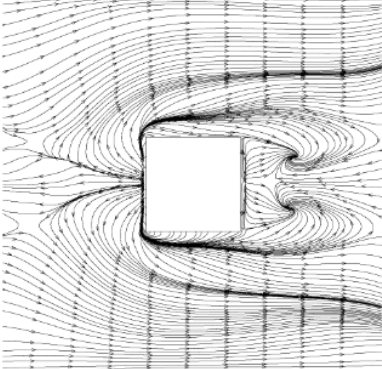
Separated flow prediction and assessment using LES and machine learning
James C. Tyacke, A. Scillitoe
Proceedings of International Conference of Numerical Analysis and Applied Mathematics, Rhodes, Greece (2020)
PDF DOI BIB
James C. Tyacke, A. Scillitoe
Proceedings of International Conference of Numerical Analysis and Applied Mathematics, Rhodes, Greece (2020)
PDF DOI BIB
Large Eddy Simulation is a predictive technology that has the potential to revolutionise CFD. Significant effort is now being put into improving lower order models based on high fidelity data. The current work contrasts LES and RANS for a low Reynolds number ribbed channel flow relevant to turbine and electronics cooling. The anisotropy of turbulence is chosen as a starting point to compare RANS modelling deficiencies, and it is found that there are significant differences between the anisotropy predicted by RANS and LES. In the LES, a spreading shear layer introduces anisotropic content into the passage. Downstream of the rib, scouring eddies shed from the rib destroy the classical boundary layer flow. A machine learning classifier trained on a database of similar flows is used to predict the anisotropy in the ribbed passage. The classifier is shown to be capable of predicting many of the flow features identified in the LES, demonstrating the potential of such approaches for application to this category of flows.

Using Machine learning to predict and understand turbulence modelling uncertainties
A. Scillitoe
Proceedings of Workshop on Frontiers of Uncertainty Quantification in Fluid Dynamics, Pisa, Italy (2019)
PDF
A. Scillitoe
Proceedings of Workshop on Frontiers of Uncertainty Quantification in Fluid Dynamics, Pisa, Italy (2019)

Large eddy simulation of boundary layer transition mechanisms in a gas-turbine compressor cascade
A. Scillitoe, P. G. Tucker, P. Adami
Proceedings of ASME Turbo Expo, Oslo, Norway (2018)
PDF DOI BIB
A. Scillitoe, P. G. Tucker, P. Adami
Proceedings of ASME Turbo Expo, Oslo, Norway (2018)
PDF DOI BIB
Large eddy simulation (LES) is used to explore the boundary layer transition mechanisms in two rectilinear compressor cascades. To reduce numerical dissipation, a novel locally adaptive smoothing (LAS) scheme is added to an unstructured finite volume solver. The performance of a number of subgrid scale (SGS) models is explored. With the first cascade, numerical results at two different freestream turbulence intensities (Ti's), 3.25% and 10%, are compared. At both Ti's, time-averaged skin-friction and pressure coefficient distributions agree well with previous direct numerical simulations (DNS). At Ti = 3.25%, separation-induced transition occurs on the suction surface, while it is bypassed on the pressure surface. The pressure surface transition is dominated by modes originating from the convection of Tollmien–Schlichting waves by Klebanoff streaks. However, they do not resemble a classical bypass transition. Instead, they display characteristics of the “overlap” and “inner” transition modes observed in the previous DNS. At Ti = 10%, classical bypass transition occurs, with Klebanoff streaks incepting turbulent spots. With the second cascade, the influence of unsteady wakes on transition is examined. Wake-amplified Klebanoff streaks were found to instigate turbulent spots, which periodically shorten the suction surface separation bubble. The celerity line corresponding to 70% of the free-stream velocity, which is associated with the convection speed of the amplified Klebanoff streaks, was found to be important.

Numerical investigation of three-dimensional separation in an axial flow compressor: the influence of freestream turbulence intensity and endwall boundary layer state
A. Scillitoe, P. G. Tucker, P. Adami
Proceedings of ASME Turbo Expo, Seoul, South Korea (2016)
PDF DOI BIB
A. Scillitoe, P. G. Tucker, P. Adami
Proceedings of ASME Turbo Expo, Seoul, South Korea (2016)
PDF DOI BIB
Regions of three-dimensional separations are an inherent flow feature of the suction surface-endwall corner in axial compressors. These corner separations can cause a significant total pressure loss and reduce the compressor's efficiency. This paper uses wall-resolved LES to investigate the loss sources in a corner separation, and examines the influence of the inflow turbulence on these sources. Different subgrid scale (SGS) models are tested and the choice of model is found to be important. The σ SGS model, which performed well, is then used to perform LES of a compressor endwall flow. The time-averaged data are in good agreement with measurements. The viscous and turbulent dissipation are used to highlight the sources of loss, with the latter being dominant. The key loss sources are seen to be the 2D laminar separation bubble and trailing edge wake, and the 3D flow region near the endwall. Increasing the freestream turbulence (FST) intensity changes the suction surface boundary layer transition mode from separation induced to bypass. However, it does not significantly alter the transition location and therefore the corner separation size. Additionally, the FST does not noticeably interact with the corner separation itself, meaning that in this case the corner separation is relatively insensitive to the FST. The endwall boundary layer state is found to be significant. A laminar endwall boundary layer separates much earlier leading to a larger passage vortex. This significantly alters the endwall flow and loss. Hence, the need for accurate boundary measurements is clear.
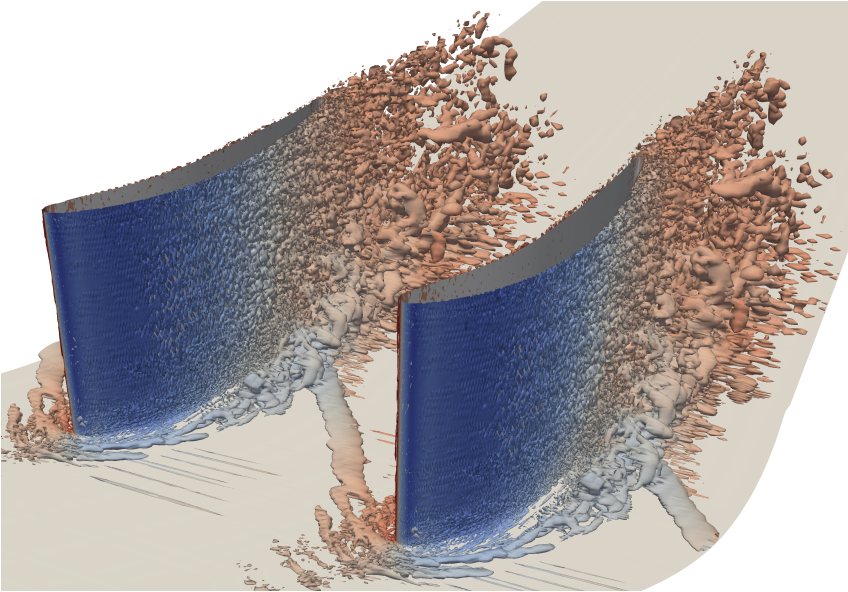
Evaluation of rans and zdes methods for the prediction of three-dimensional separation in axial flow compressors
A. Scillitoe, P. G. Tucker, P. Adami
Proceedings of ASME Turbo Expo, Montreal, Canada (2015)
PDF DOI BIB
A. Scillitoe, P. G. Tucker, P. Adami
Proceedings of ASME Turbo Expo, Montreal, Canada (2015)
PDF DOI BIB
Regions of three-dimensional separations are an inherent flow feature of the corner formed by the suction surface and endwall of axial compressors. RANS turbulence models, common in industrial CFD codes, often struggle in these regions. This paper investigates the use of two hybrid RANS/LES methods as alternatives to pure RANS methods. SA and SST based Zonal DES (ZDES) are applied to a linear blade cascade case, studied experimentally by Gbadebo [1]. The time-averaged results are compared to steady SA, SST and RSM RANS results. SA model corrections for streamline curvature, anisotropy and non-equilibrium effects are also examined. For the ZDES computations the solver is modified to reduce dissipation at low Mach numbers. Significant uncertainty is observed in the RANS results, with the origin of the suction surface corner separation occurring too far upstream, and the extent of the corner separation significantly over-predicted. The laminar separation bubble and the turbulent reattachment are also missed. Consequently the surface pressure distribution, exit flow angle and total pressure loss predictions are poor. Conversely, the ZDES results were encouraging; with much better predictions of the pressure distribution, exit flow angle and trailing edge boundary layer displacement thickness. Some RANS corrections proved effective, such as the SA model with Rotation/Curvature correction (SA-RC), however all had deficiencies in some areas. Although the ZDES results are encouraging it is noted that these computations were two orders of magnitude more computaionally expensive due to the high mesh densities and small time-steps required. For the ZDES results quality indexes are examined in order to determine whether the computational mesh used is sufficient in different flow regions. Mesh generation strategies based on using a pre-cursor RANS solution to obtain a modelled energy spectrum and various turbulent length scales to guide mesh refinement are considered. These can provide a quick estimate of the potential computational cost of LES or hybrid RANS/LES computations from a RANS solution.

An engineering development of a novel hexrotor vehicle for 3D applications
D. Langkamp, G. Roberts, A. Scillitoe, I. Lunnon, A. Llopis-Pascual, J. Zamecnik, S. Proctor, M. Rodriguez-Frias, M. Turner, A. Lanzon, W. Crowther
Proceedings of International Micro Air Vehicle Conference and Competitions, 't Harde, The Netherlands (2011)
PDF DOI BIB
D. Langkamp, G. Roberts, A. Scillitoe, I. Lunnon, A. Llopis-Pascual, J. Zamecnik, S. Proctor, M. Rodriguez-Frias, M. Turner, A. Lanzon, W. Crowther
Proceedings of International Micro Air Vehicle Conference and Competitions, 't Harde, The Netherlands (2011)
PDF DOI BIB
This paper is about the development of a novel type of non-coplanar hex rotor with the ability to decouple translational and attitude dynamics. The proposed design features six variable pitch rotors arranged in three different rotor planes in order to point the thrust and torque vectors independently of body attitude. It is envisaged that this design could be beneficial for operations in confined spaces where the requirements for translational control authority design outweigh the reduced hover efficiency compared to coplanar multi rotors, such as quad rotors. The rotor arrangement leads to design and modeling challenges which are very different from those of conventional planar multi rotor vehicles. The key engineering challenge lies in the requirement to generate sufficient thrust for weight support with two rotors alone. This paper shows how this challenge was overcome by the use of high thrust/weight electric variable pitch units and a low airframe mass fraction. The design of avionics and indoor positioning solutions is discussed and the control strategies are outlined. The development and wind tunnel validation of a simulation model is discussed and operational modes are presented which satisfy the key constraints, linearise the thrust response and optimise hover efficiency. The feasibility of the concept was demonstrated through the flight testing of fixed-pitch design in 2009 and a flight demonstration of the variable pitch design is planned for IMAV 2011.
Doctoral Thesis

Towards Predictive Eddy Resolving Simulations for Gas Turbine Compressors
A. Scillitoe
PhD Thesis, University of Cambridge (2017)
PDF DOI BIB
A. Scillitoe
PhD Thesis, University of Cambridge (2017)
PDF DOI BIB
This thesis aims to explore the potential for using large eddy simulation (LES) as a predictive tool for gas-turbine compressor flows. Compressors present a significant challenge for the Reynolds Averaged Navier-Stokes (RANS) based CFD methods commonly used in industry. RANS models require extensive calibration to experimental data, and thus cannot be used predictively. This thesis explores how LES can offer a more predictive alternative, by exploring the sensitivity of LES to sources of uncertainty. Specifically, the importance of the numerical scheme, the Sub-Grid Scale (SGS) model, and the correct specification of inflow turbulence is examined. The sensitivity of LES to the numerical scheme is explored using the Taylor-Green vortex test case. The numerical smoothing, controlled by a user defined smoothing constant, is found to be important. To avoid tuning the numerical scheme, a novel scheme, the LAS with windowing (LASW) scheme, is introduced. The LASW scheme is used to perform LES on a compressor cascade, and results are found to be in close agreement with direct numerical simulations. Complex transition mechanisms, combining characteristics of both natural and bypass modes, are observed on the pressure surface. On the suction surface, separation induced transition occurs. The results demonstrate that, with the LASW scheme and a suitable SGS model, LES can be used predictively in compressor flows. In order to be predictive, the accurate specification of inflow conditions was shown to be just as important as the numerics. RANS models are shown to over-predict the extent of the three dimensional separation in the endwall - suction surface corner. LES is used to examine the challenges for RANS in this region. The LES shows that it is important to accurately capture the suction surface transition location, with early transition leading to a larger endwall separation. Large scale aperiodic unsteadiness is also observed in the endwall region. Additionally, turbulent anisotropy in the endwall - suction surface corner is found to be important. Adding a non-linear term to the RANS model leads to turbulent stresses that are in better agreement with the LES. This results in a stronger corner vortex which is thought to delay the corner separation. The addition of a corner fillet reduces the importance of anisotropy, thereby reducing the uncertainty in the RANS prediction.
Recent Talks
- Workshop: An Introduction to Drift Detection (2022), Toronto Machine Learning Summit, Toronto, Canada.
- Combating drift in production ML (2022), MLPrague, Prague, Czech Republic.
- An Introduction to Drift Detection (2022), Open Data Science Conference East, Boston, USA.
